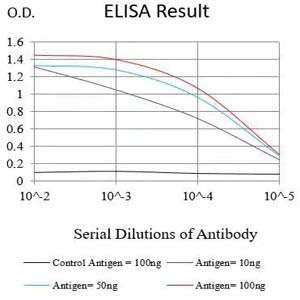
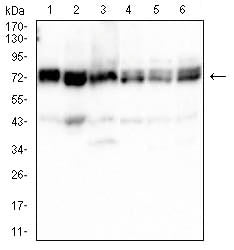
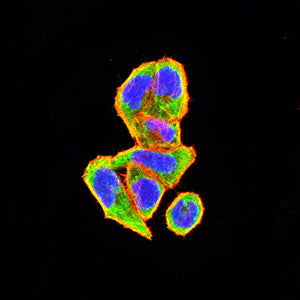
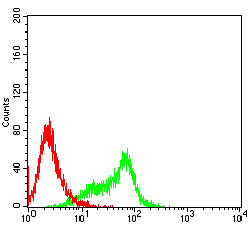
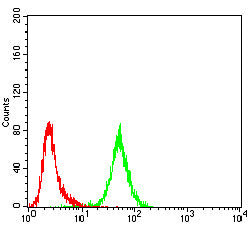
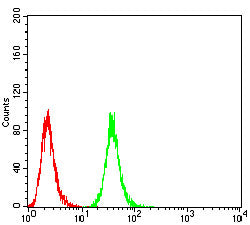
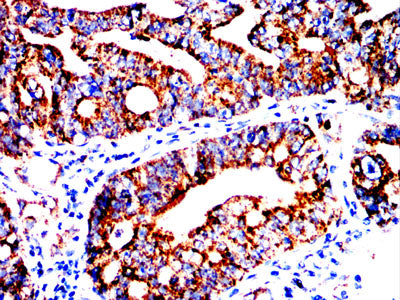
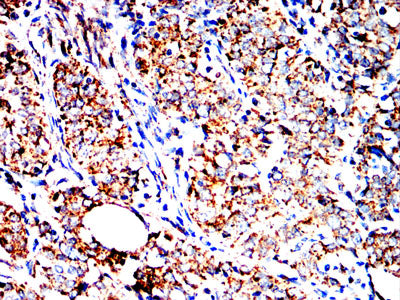
| WB | 1/500 - 1/2000 | Human, Mouse, Monkey, Rat |
| IF | 咨询技术 | Human, Mouse, Monkey, Rat |
| IHC | 1/200 - 1/1000 | Human, Mouse, Monkey, Rat |
| ICC | 1/200 - 1/1000 | Human, Mouse, Monkey, Rat |
| FCM | 1/200 - 1/400 | Human, Mouse, Monkey, Rat |
| Elisa | 1/10000 | Human, Mouse, Monkey, Rat |
| Aliases | CSA; MOT; MOT2; SAAN; CRP40; EVPLS; GRP75; PBP74; GRP-75; HSPA9B; SIDBA4; MTHSP75; HEL-S-124m |
| Entrez GeneID | 3313 |
| clone | 8D2D11 |
| WB Predicted band size | 74KDa |
| Host/Isotype | Mouse IgG2a |
| Antibody Type | Primary antibody |
| Storage | Store at 4°C short term. Aliquot and store at -20°C long term. Avoid freeze/thaw cycles. |
| Species Reactivity | Human, Mouse, Monkey, Rat |
| Immunogen | Purified recombinant fragment of human HSPA9 (AA: 480-679) expressed in mammalian. |
| Formulation | Purified antibody in PBS with 0.05% sodium azide |
+ +
以下是关于HSPA9抗体的3篇参考文献及其摘要概括:
---
1. **文献名称**: *Mortalin/GRP75 promotes endogenous DNA damage and functional deficits in cerebral ischemia*
**作者**: Liu Y, et al.
**摘要**: 该研究通过免疫印迹和免疫荧光技术,利用HSPA9抗体发现脑缺血模型中HSPA9的异常表达与DNA损伤及神经元功能缺陷相关,提示其可能通过调控线粒体功能参与缺血性损伤机制。
---
2. **文献名称**: *Mortalin regulates apoptosis through interaction with p53 in cancer cells*
**作者**: Kaul SC, et al.
**摘要**: 研究采用HSPA9特异性抗体进行免疫共沉淀和免疫组化实验,揭示HSPA9通过结合并抑制p53的促凋亡活性,促进癌细胞存活,为靶向HSPA9的癌症治疗提供依据。
---
3. **文献名称**: *Mitochondrial import and assembly of HSPA9 in neurodegenerative disorders*
**作者**: Burbulla LF, et al.
**摘要**: 通过Western blot和线粒体分离技术结合HSPA9抗体,发现帕金森病模型中HSPA9的线粒体定位异常,导致蛋白质输入缺陷,可能加剧神经退行性病变。
---
这些文献展示了HSPA9抗体在疾病机制研究中的关键作用,涵盖脑缺血、癌症及神经退行性疾病等领域。
The HSPA9 antibody is a crucial tool for studying the HSPA9 protein, a member of the heat shock protein 70 (HSP70) family. HSPA9. also known as GRP75 or mortalin, is a mitochondrial chaperone involved in protein folding, mitochondrial protein import, and stress response. It plays essential roles in maintaining mitochondrial function, regulating apoptosis, and supporting cellular homeostasis. Dysregulation of HSPA9 has been linked to various diseases, including cancer, neurodegenerative disorders (e.g., Alzheimer’s and Parkinson’s), and metabolic syndromes.
The HSPA9 antibody enables researchers to detect and quantify HSPA9 expression in tissues or cell lines using techniques like Western blotting, immunofluorescence, and immunohistochemistry. It also aids in studying its subcellular localization, interactions with client proteins (e.g., p53. telomerase), and involvement in mitochondrial dynamics. Commercial HSPA9 antibodies are typically raised against specific epitopes, such as the N-terminal or C-terminal regions, and validated for cross-reactivity across species (human, mouse, rat).
Research using HSPA9 antibodies has revealed its dual role in cancer—acting as both a tumor suppressor and promoter depending on context—and its association with chemoresistance. In neurodegeneration, HSPA9 depletion correlates with mitochondrial dysfunction and protein aggregation. As a biomarker or therapeutic target, HSPA9 remains under investigation, highlighting the antibody's importance in mechanistic and translational studies.
×